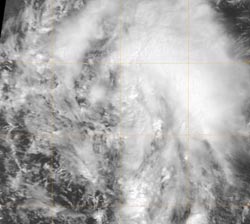NASA sees fifteenth Atlantic tropical depression born

NASA's Terra satellite passed over newborn Tropical Depression 15 on Oct. 3 at 8:52 a.m. EDT in the central Atlantic Ocean.<br><br>Credit: NASA/NRL<br>
NASA's Terra satellite passed over newborn Tropical Depression 15 on Oct. 3 at 8:52 a.m. EDT in the central Atlantic Ocean and the Moderate Resolution Imaging Spectroradiometer (MODIS) instrument captured an image of the storm.
Shortly after the image was created, forecasters at the National Hurricane Center looking at the MODIS and other satellite data determined that the low pressure area had become a depression.
On Oct. 3 at 11 a.m. EDT, the center of tropical depression fifteen (TD15) was located near latitude 17.3 north and longitude 41.5 west, about 1,160 miles (1,870 km) west of the Cape Verde Islands.
The depression is moving toward the northwest near 15 mph (24 kmh) and is expected to turn north and slow down by Oct. 4 before turning to the northeast. TD15's maximum sustained winds were near 35 mph (55 kph). TD15's estimated minimum central pressure was 1008 millibars.
The depression is expected to strengthen into Tropical Storm Oscar later on Oct. 3 or by Oct. 4 and move to the north and northeast. The National Hurricane Center does not expect Oscar to last very long because it is forecast to move into hostile atmospheric territory.
Media Contact
More Information:
http://www.nasa.govAll latest news from the category: Earth Sciences
Earth Sciences (also referred to as Geosciences), which deals with basic issues surrounding our planet, plays a vital role in the area of energy and raw materials supply.
Earth Sciences comprises subjects such as geology, geography, geological informatics, paleontology, mineralogy, petrography, crystallography, geophysics, geodesy, glaciology, cartography, photogrammetry, meteorology and seismology, early-warning systems, earthquake research and polar research.
Newest articles

A universal framework for spatial biology
SpatialData is a freely accessible tool to unify and integrate data from different omics technologies accounting for spatial information, which can provide holistic insights into health and disease. Biological processes…

How complex biological processes arise
A $20 million grant from the U.S. National Science Foundation (NSF) will support the establishment and operation of the National Synthesis Center for Emergence in the Molecular and Cellular Sciences (NCEMS) at…

Airborne single-photon lidar system achieves high-resolution 3D imaging
Compact, low-power system opens doors for photon-efficient drone and satellite-based environmental monitoring and mapping. Researchers have developed a compact and lightweight single-photon airborne lidar system that can acquire high-resolution 3D…





















